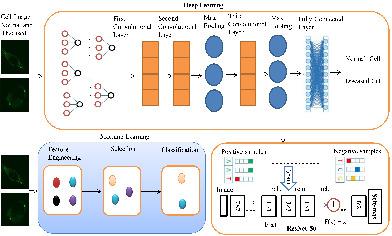当前位置:
X-MOL 学术
›
Trans. Emerg. Telecommun. Technol.
›
论文详情
Our official English website, www.x-mol.net, welcomes your
feedback! (Note: you will need to create a separate account there.)
Deep learning recognition of diseased and normal cell representation
Transactions on Emerging Telecommunications Technologies ( IF 2.5 ) Pub Date : 2020-07-06 , DOI: 10.1002/ett.4017 Muhammad Shahid Iqbal 1, 2 , Iftikhar Ahmad 3 , Luo Bin 1 , Suleman Khan 4 , Joel J. P. C. Rodrigues 5, 6
Transactions on Emerging Telecommunications Technologies ( IF 2.5 ) Pub Date : 2020-07-06 , DOI: 10.1002/ett.4017 Muhammad Shahid Iqbal 1, 2 , Iftikhar Ahmad 3 , Luo Bin 1 , Suleman Khan 4 , Joel J. P. C. Rodrigues 5, 6
Affiliation

|
Cell classification refers to detecting normal and diseased cells from small amount of data. Sometimes, classification of cells becomes difficult because some cells fall into more than one categories/classes. Current state-of-the-art cell classification methods have been developed on the bases of tumor cell classification but these methods cannot classify diseased or normal cells. This study investigated the performance of two classification methods traditional machine learning and deep learning (normal and diseased cell classification) to categorize normal and diseased cells. Millions of normal cells undergo controlled growth and uncontrolled growth may be involved in disease causation but their clinical applications remain limited due to difficulties in distinguishing normal and diseased cells. Previous studies are limited to identify, systematically, the normal and diseased cells. This study collected information about diseased or normal cells to check the networks for correct cell detection and then eliminated false-positive cells. We used machine learning methods along with logistic regression, support vector machine, and CNN (convolutional neural network). We found that our proposed method classified better the normal and diseased cells. With the help of two types of images: normal and diseased cells, we trained a CNN that identified diseased cells with 98% accuracy and enabled the discovery of normal and diseased cells. As a result, it will advance the clinical utility of human diseased cells.
中文翻译:

病变和正常细胞表征的深度学习识别
细胞分类是指从少量数据中检测正常细胞和病变细胞。有时,细胞分类变得困难,因为一些细胞属于多个类别/类别。目前最先进的细胞分类方法是在肿瘤细胞分类的基础上发展起来的,但这些方法不能对病变细胞或正常细胞进行分类。本研究调查了传统机器学习和深度学习(正常和患病细胞分类)两种分类方法对正常和患病细胞进行分类的性能。数以百万计的正常细胞进行受控生长,不受控制的生长可能与疾病病因有关,但由于难以区分正常细胞和患病细胞,因此它们的临床应用仍然有限。以前的研究仅限于确定,系统地,正常细胞和患病细胞。这项研究收集了有关患病或正常细胞的信息,以检查网络以进行正确的细胞检测,然后消除假阳性细胞。我们使用机器学习方法以及逻辑回归、支持向量机和 CNN(卷积神经网络)。我们发现我们提出的方法对正常细胞和患病细胞进行了更好的分类。借助两种类型的图像:正常细胞和患病细胞,我们训练了一个 CNN,它以 98% 的准确率识别患病细胞,并能够发现正常细胞和患病细胞。因此,它将促进人类患病细胞的临床应用。这项研究收集了有关患病或正常细胞的信息,以检查网络以进行正确的细胞检测,然后消除假阳性细胞。我们使用机器学习方法以及逻辑回归、支持向量机和 CNN(卷积神经网络)。我们发现我们提出的方法对正常细胞和患病细胞进行了更好的分类。借助两种类型的图像:正常细胞和患病细胞,我们训练了一个 CNN,它以 98% 的准确率识别患病细胞,并能够发现正常细胞和患病细胞。因此,它将促进人类患病细胞的临床应用。这项研究收集了有关患病或正常细胞的信息,以检查网络以进行正确的细胞检测,然后消除假阳性细胞。我们使用机器学习方法以及逻辑回归、支持向量机和 CNN(卷积神经网络)。我们发现我们提出的方法对正常细胞和患病细胞进行了更好的分类。借助两种类型的图像:正常细胞和患病细胞,我们训练了一个 CNN,它以 98% 的准确率识别患病细胞,并能够发现正常细胞和患病细胞。因此,它将促进人类患病细胞的临床应用。借助两种类型的图像:正常细胞和患病细胞,我们训练了一个 CNN,它以 98% 的准确率识别患病细胞,并能够发现正常细胞和患病细胞。因此,它将促进人类患病细胞的临床应用。借助两种类型的图像:正常细胞和患病细胞,我们训练了一个 CNN,它以 98% 的准确率识别患病细胞,并能够发现正常细胞和患病细胞。因此,它将促进人类患病细胞的临床应用。
更新日期:2020-07-06
中文翻译:

病变和正常细胞表征的深度学习识别
细胞分类是指从少量数据中检测正常细胞和病变细胞。有时,细胞分类变得困难,因为一些细胞属于多个类别/类别。目前最先进的细胞分类方法是在肿瘤细胞分类的基础上发展起来的,但这些方法不能对病变细胞或正常细胞进行分类。本研究调查了传统机器学习和深度学习(正常和患病细胞分类)两种分类方法对正常和患病细胞进行分类的性能。数以百万计的正常细胞进行受控生长,不受控制的生长可能与疾病病因有关,但由于难以区分正常细胞和患病细胞,因此它们的临床应用仍然有限。以前的研究仅限于确定,系统地,正常细胞和患病细胞。这项研究收集了有关患病或正常细胞的信息,以检查网络以进行正确的细胞检测,然后消除假阳性细胞。我们使用机器学习方法以及逻辑回归、支持向量机和 CNN(卷积神经网络)。我们发现我们提出的方法对正常细胞和患病细胞进行了更好的分类。借助两种类型的图像:正常细胞和患病细胞,我们训练了一个 CNN,它以 98% 的准确率识别患病细胞,并能够发现正常细胞和患病细胞。因此,它将促进人类患病细胞的临床应用。这项研究收集了有关患病或正常细胞的信息,以检查网络以进行正确的细胞检测,然后消除假阳性细胞。我们使用机器学习方法以及逻辑回归、支持向量机和 CNN(卷积神经网络)。我们发现我们提出的方法对正常细胞和患病细胞进行了更好的分类。借助两种类型的图像:正常细胞和患病细胞,我们训练了一个 CNN,它以 98% 的准确率识别患病细胞,并能够发现正常细胞和患病细胞。因此,它将促进人类患病细胞的临床应用。这项研究收集了有关患病或正常细胞的信息,以检查网络以进行正确的细胞检测,然后消除假阳性细胞。我们使用机器学习方法以及逻辑回归、支持向量机和 CNN(卷积神经网络)。我们发现我们提出的方法对正常细胞和患病细胞进行了更好的分类。借助两种类型的图像:正常细胞和患病细胞,我们训练了一个 CNN,它以 98% 的准确率识别患病细胞,并能够发现正常细胞和患病细胞。因此,它将促进人类患病细胞的临床应用。借助两种类型的图像:正常细胞和患病细胞,我们训练了一个 CNN,它以 98% 的准确率识别患病细胞,并能够发现正常细胞和患病细胞。因此,它将促进人类患病细胞的临床应用。借助两种类型的图像:正常细胞和患病细胞,我们训练了一个 CNN,它以 98% 的准确率识别患病细胞,并能够发现正常细胞和患病细胞。因此,它将促进人类患病细胞的临床应用。







































 京公网安备 11010802027423号
京公网安备 11010802027423号